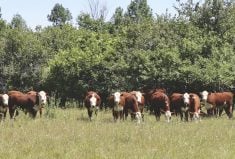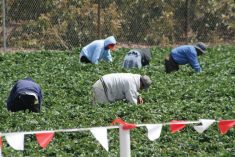An intrepid group of cyclists recently set out to explore the Battle River watershed on an innovative tour, spending three days travelling to small towns and hidden gems in the area.
“The intention of the tour has been looking at all of our different energy options,” said Nathalie Stanley Olson, education and outreach co-ordinator with the Battle River Watershed Alliance. “Over the last few days, we’ve had a lot of stops at different energy producers. So we’ve been learning how coal actually works, or how it’s dug out.”
Read Also

Farming Smarter receives financial boost from Alberta government for potato research
Farming Smarter near Lethbridge got a boost to its research equipment, thanks to the Alberta government’s increase in funding for research associations.
About 15 people participated all three days, with others joining for one leg or another of the tour earlier this month. Participants came from Wainwright, Edmonton, Forestburg, Hardisty and Rosalind. The group biked from Camrose to Forestburg, and to Halkirk and Hardisty, battling through an early-September heat wave with temperatures reaching 32 C.
“I’ll take a little heat over it being rainy,” Olson said with a laugh.
The tour’s theme was Finding Common Ground, and participants said one of the highlights was experiencing new things and seeing others differently.
“People have become aware that coal and the power plant aren’t really these big bad guys that sometimes the media paints them as,” said Peter Miller, who has been the mayor of Forestburg for 25 years. “It was nice to see the other perspective and to have people visiting realize that and go away with a more reasonable picture of what’s happening.”
Another tour theme was resiliency, with stops at wind turbines and a farm with solar panels.
“I think having all these different energy options is pretty good,” said Olson. “I feel a lot more secure than some of the other areas of the province or country.”
There was also a visit to Prairie Land and Cattle Company, a cattle and cropping operation. Owner Cliff Drever cycled on the tour and said it was a good opportunity for people to learn more about their neighbours.
A special highlight was a visit to the Lougheed Hutterite Colony school. Students, cheered the cyclists as they arrived, and showed them trees that they had planted a couple of years ago. The four oldest students have built bird feeders, and will be building homes for wild bees in the fall.
“We have honeybees on the colony, but of course, we want to support the wild bees,” said teacher Cheryl Fotheringham. “We have a huge garden down there, and we want to do our part to help the environment.”
Participants were served popsicles, iced tea and lemonade by the Hutterite students, who were told about the watershed and the tour as well.
“What we’re talking about is how we can most efficiently conserve our energy so we can save a lot for the future as well,” Olson said to the students. “We all live here together so how do we make sure we all protect our environment and make sure it’s all clean going forwards?”
She explained to the students that the tour was taking place on bikes because it offered a chance to slow down and look at the scenery differently.
“We’re using our own people power as well. We’re also talking about how we get our food and how we power ourselves so we can keep cycling,” she said.
In the Battle River watershed, about 70 per cent of the land use is agricultural, so it made sense to do many farm stops.
At Prairie Land and Cattle Company in Hardisty, participants enjoyed a barbecue lunch and a talk from Edward Bork, who explained the University of Alberta’s research into carbon sequestration in soil. They also learned about the activities of the Prairie Land and Cattle Company from manager Ben Stuart. The 16,000-acre farm is located near Hardisty and also has a Saskatchewan operation. Drever has made use of his international staff, many from New Zealand, to get new ideas about how to improve organic grain production, cover cropping, and cattle ranching.
The three-day tour will be featured in a documentary created by Alison Bortolon of Camrose. The video will be shown at community meetings this winter to raise awareness and foster discussions about current and future energy production in east-central Alberta.
















